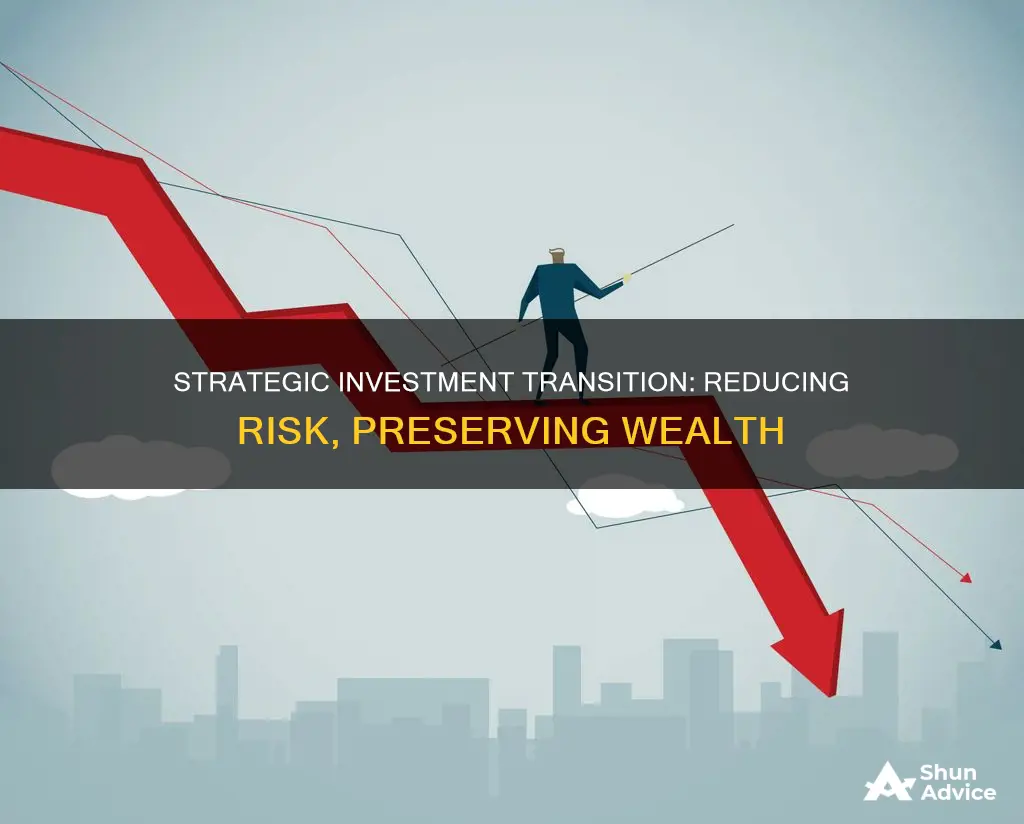
Transitioning investments to lower-risk assets is a crucial aspect of financial planning, especially as one approaches retirement. While investing in high-risk assets such as stocks can offer higher returns, it is important to balance this with more conservative investments to protect against potential losses. This is particularly relevant in the context of retirement planning, where a significant drop in portfolio value can jeopardise one's financial stability during retirement.
The process of transitioning to lower-risk investments should be guided by a comprehensive evaluation of one's financial goals, risk tolerance, time horizon, and life circumstances. This involves understanding the potential impact of market fluctuations and ensuring that the portfolio aligns with one's comfort level and long-term objectives.
Additionally, it is essential to consider the specific risks associated with different investments, such as transition risks, which can arise from changes in a company's status or operations. Diversification, hedging, insurance, and careful planning are all strategies that can help mitigate these risks and protect one's financial well-being.
By regularly reassessing risk tolerance and adjusting investment strategies, individuals can effectively transition their investments to lower-risk assets, ensuring a more secure financial future.
| Characteristics | Values |
|---|---|
| Risk tolerance | Evaluate your comfort zone in taking on risk. Understand that all investments involve some degree of risk. |
| Financial goals | Determine your financial goals, such as saving for retirement, a child's education, or purchasing a home. |
| Time horizon | Consider your investment horizon. Shorter time horizons typically mean lower-risk investments, while longer time horizons may allow for higher-risk options. |
| Diversification | Diversify your investments across different asset classes, industries, and geographies to reduce the impact of losses in any specific area. |
| Life circumstances | Take into account significant life events, such as marriage, starting a family, job changes, income fluctuations, and life emergencies. |
| Emergency fund | Create and maintain an emergency fund to cover unexpected expenses. |
| Debt | Pay off high-interest credit card debt to reduce financial strain and improve cash flow. |
| Rebalancing | Occasionally rebalance your portfolio to maintain your desired asset allocation and risk level. |
| Education | Educate yourself on investing, market conditions, and risk management strategies to make informed decisions. |
| Planning | Develop a financial plan that aligns with your goals and risk tolerance. |
What You'll Learn

Evaluate your risk tolerance
Evaluating your risk tolerance is crucial when deciding how to transition your investments to less risk. Risk tolerance refers to the degree of variability in investment returns that you are willing to accept. It is a subjective measure of your comfort with the market's ups and downs and the potential for loss. Understanding your risk tolerance will help you determine the types of investments that align with your personal comfort levels. Here are some factors to consider when evaluating your risk tolerance:
Time Horizon
The time horizon until you need to access your investment funds is a critical factor in determining your risk tolerance. Generally, if you have a longer time horizon, you can tolerate more risk as you have more time to recover from short-term market fluctuations and losses. Conversely, if your time horizon is shorter, you may want to opt for less risky investments to protect your capital and ensure a stable income stream. For example, if you're nearing retirement, you may want to transition to more conservative investments to safeguard your savings.
Income and Financial Stability
A steady and predictable income stream can provide a safety net, allowing you to take on more risk in your investments. With a stable income, you can afford to invest in higher-risk, higher-reward assets and diversify your portfolio across different asset classes. On the other hand, if your income is lower or less predictable, you may prefer safer investments like savings accounts, bonds, and low-volatility mutual funds to preserve your capital and avoid financial strain.
Life Circumstances and Personal Goals
Significant life events, such as getting married, starting a family, or planning for retirement, can impact your risk tolerance. These events often shift your focus towards financial security and stability, leading you to favour more conservative investments. In contrast, receiving a financial windfall or inheritance might increase your willingness to take on more risk. It's important to align your investment strategy with your personal goals to ensure you're taking on an appropriate level of risk while achieving your objectives.
Investment Experience
Your level of investment experience can also influence your risk tolerance. Seasoned investors who have navigated different market cycles may have a higher risk tolerance as they are more familiar with market volatility and have developed risk management strategies. On the other hand, if you're new to investing, you may have a lower risk tolerance due to the fear of the unknown and potential losses. However, educating yourself about the market and starting with small-scale investments can gradually increase your comfort level and risk tolerance over time.
Psychological Factors
Your personality traits and behavioural biases play a crucial role in determining your risk tolerance. If you are naturally risk-averse, you may prefer safer investments that offer stability and security. In contrast, if you have a risk-seeking personality, you may be more comfortable with market volatility and potential losses in pursuit of higher returns. It's important to balance this trait with prudent risk management to avoid excessive losses that could derail your financial goals.
Market Conditions
Market conditions, such as a bull or bear market, can also impact your risk tolerance. In a bull market, characterised by rising stock prices and economic optimism, you may be more willing to invest in higher-risk assets, expecting continued growth. On the other hand, during a bear market, you may shift towards safer investments as prices fall and market sentiment becomes pessimistic.
By considering these factors, you can better evaluate your risk tolerance and make informed decisions about transitioning your investments to less risk. Remember, risk tolerance is not static; it can evolve over time as your financial circumstances, investment experience, and personal goals change. Regularly reassessing your risk tolerance will help you maintain a balanced and effective investment portfolio.
Small Investments, Big Returns: 10X Your Money
You may want to see also

Diversify your investments
Diversifying your investments is a crucial strategy to reduce risk and protect your finances. Here are some detailed instructions on how to diversify your investments:
Understand the Concept of Diversification
Diversification is a risk management strategy that involves spreading your investments across various asset classes, industries, and geographic locations. By allocating your investments in this way, you reduce the impact of any single investment loss on your overall portfolio. In other words, you don't put all your eggs in one basket. Diversification is a way to manage the specific risks associated with changes in a company's status or circumstances, such as mergers or acquisitions.
Assess Your Current Investments
Before making any changes, take stock of your current investment portfolio. Identify the types of assets you currently hold and the industries and geographic regions they focus on. Look for any concentrations or overlaps that may increase your risk. For example, if most of your investments are in the technology sector, you may be vulnerable to technology industry downturns.
Determine Your Risk Tolerance
Risk tolerance refers to how much variability in investment returns you are willing to accept. It is influenced by factors such as your age, income, financial goals, and personality traits. Younger investors tend to have a higher risk tolerance because they have more time to recover from short-term losses. As you approach retirement, your risk tolerance typically decreases, and you may seek to preserve your capital and ensure a stable income.
Allocate Your Investments Across Asset Classes
Diversify Within Each Asset Class
Diversification doesn't just mean investing in different asset classes; it also involves spreading your investments within each class. For example, if you invest in stocks, allocate your funds across different sectors (e.g., technology, healthcare, finance) and avoid concentrating too heavily in one industry. Similarly, if you invest in real estate, consider purchasing properties in different locations and tenant types to reduce the impact of local market fluctuations.
Consider Using Mutual Funds or ETFs
Mutual funds and exchange-traded funds (ETFs) offer built-in diversification because they pool your money with that of other investors to purchase a diversified portfolio of assets. These funds typically hold a mix of stocks, bonds, and other investments, providing instant diversification. Index funds and ETFs are particularly useful for diversifying as they are designed to track a specific market index, providing broad exposure to a variety of investments.
Regularly Review and Rebalance Your Portfolio
Diversification is an ongoing process. Regularly review your investment portfolio to ensure it remains aligned with your risk tolerance and financial goals. Over time, some investments may outperform others, causing your portfolio to become unbalanced. Rebalancing involves adjusting your portfolio back to your desired asset allocation. This may involve buying more of the investments that have fallen in value and selling a portion of those that have grown, bringing your portfolio back to a comfortable level of risk.
Strategies for Growth in Investment Management
You may want to see also

Plan for emergencies
Planning for emergencies is a crucial aspect of transitioning your investments to less risk. Here are some detailed instructions to help you prepare for unexpected situations:
- Create an emergency fund: Set aside a portion of your income or investments into a dedicated emergency fund. Aim to save enough to cover unexpected expenses, such as sudden unemployment or medical emergencies. As a guideline, consider saving up to six months' worth of your income to ensure you have a solid financial cushion.
- Pay off high-interest debt: Eliminating high-interest debt, especially credit card debt, should be a priority. Focus on paying off these debts as quickly as possible. By doing so, you reduce the financial strain and risk associated with high-interest payments.
- Maintain adequate insurance: Ensure you have appropriate insurance policies in place to protect against potential risks. Consider your specific circumstances and needs, and review insurance options such as health insurance, life insurance, property insurance, or other relevant types.
- Diversify your investments: Diversification is a powerful tool to manage risk. Spread your investments across different asset classes, industries, and geographic locations. By doing so, you reduce the impact of any single investment loss and lower your overall risk exposure.
- Regularly review and rebalance your portfolio: Stay vigilant by regularly reviewing your investment portfolio. Monitor your risk exposure and adjust your investments accordingly. If certain investments are performing poorly or carry high risk, consider rebalancing your portfolio to maintain a comfortable level of risk.
- Prepare for major life events: Anticipate significant life events, such as marriage, having children, or retirement, and adjust your investments accordingly. These events often bring changes in financial needs and goals, which should be reflected in your investment strategy.
- Seek professional advice: Consult a financial advisor or planner to help you tailor your investment strategy to your specific circumstances. They can provide valuable insights and guidance on risk management, emergency planning, and overall financial wellness.
Remember, planning for emergencies is a dynamic process. Regularly assess your financial situation, identify potential risks, and make adjustments to your investments and emergency funds as necessary. By being proactive and prepared, you can effectively manage risks and protect your financial well-being.
Assessing Investment Bankers' Risk Appetite: Strategies and Secrets
You may want to see also

Avoid high-interest debt
Transitioning your investments to less risk is a good idea as you approach retirement, or if your financial circumstances change. One of the best ways to reduce risk is to pay off high-interest debt. Credit cards, personal loans, and private student loans tend to have the highest interest rates. These can be as high as 300% in the case of payday loans. Credit cards can charge as much as 18% or more, and the average interest rate is now 23.39%.
High-interest debt can be expensive and challenging to pay off. The longer it goes unpaid, the more difficult it becomes to manage. The interest compounds over time, and your debt can grow quickly. It is recommended that you pay off these debts before focusing on other financial goals, as they can divert funds away from other important milestones.
- Understand your debt: Figure out what you are paying in month-to-month debt. To prioritize what should be paid off first, identify the sources of high interest.
- Pay off the card with the highest rate: If you have unpaid balances on multiple credit cards, focus on paying off the card with the highest interest rate first. Pay as much as you can towards that debt each month while still paying the minimum on your other cards.
- Make more than the minimum payment: Making only the minimum payment on your credit card balances will cost you more in interest over time. Aim to pay more than the minimum each month to make a larger impact on what you owe.
- Debt consolidation: If you have multiple sources of high-interest debt, consider debt consolidation. This process allows you to combine all your debts into a single new loan, ideally with a lower interest rate and more favorable repayment terms. Personal loans typically have lower interest rates than credit cards and can make it easier to manage your debt.
- Zero-interest balance transfers: Many credit card companies offer zero-interest balance transfers for a set period, usually 12 months. During this time, you can pay down the balance more quickly as you are not charged interest each month.
- Lower-rate loans: For those who qualify, personal loans can provide a lower-interest option for consolidating and paying off debt.
- Home equity options: If you own a home, you can use the equity you have built up to pay off high-interest debt. Options include a home equity installment loan, a home equity line of credit (HELOC), or a fixed-rate lock HELOC.
Remember, no investment strategy will pay off as well, or with less risk, than eliminating high-interest debt.
Investment Management SA: Strategies for Success
You may want to see also

Consider your investment timeline
When considering how to transition your investments to less risk, it is important to take into account your investment timeline. This is because your financial timeline can influence your risk tolerance, with shorter timelines generally indicating a lower risk tolerance and longer timelines suggesting a higher tolerance.
If your investment horizon is longer than 10 years, you may want to consider relatively higher-risk investments that offer the potential for higher returns, such as stocks. This is because you have a longer time frame to ride out any downturns in the market and benefit from potential gains over time. On the other hand, if your timeline is less than two years, you will likely want to focus on lower-risk investments to ensure that short-term market fluctuations do not significantly impact your financial goals. Income-generating investments and investments that tend to be lower risk, such as bonds, may be more suitable in this case.
For those with a timeline between two and 10 years, a mix of stocks and more conservative investments is often recommended. This allows you to benefit from the potential gains of stocks while also balancing your portfolio with more stable options.
It is also important to consider any significant life events that may impact your timeline and risk tolerance. For example, if you are nearing retirement, you may want to gradually shift to a more conservative portfolio to protect your savings. Other life events such as changing jobs, getting married, getting divorced, or having children can also influence your financial goals and risk tolerance, prompting a re-evaluation of your investment strategy.
Additionally, it is worth noting that your investment timeline and risk tolerance are not static and can change over time. Regularly reassessing your timeline, risk tolerance, and investment strategies is crucial for maintaining a balanced and effective portfolio that aligns with your financial goals.
Roth Retirement Accounts: Smart Investment or Waste of Money?
You may want to see also
Frequently asked questions
The first step is to draw a personal financial roadmap. This involves taking an honest look at your entire financial situation, including your goals and risk tolerance.
Your risk tolerance is your comfort level with the potential ups and downs of the market, including the possibility of losing some or all of your money. It is influenced by factors such as age, income, life circumstances, and personality traits.
A good time to transition is when you experience a significant life event, such as retirement, a change in jobs, getting married/divorced, or having children. Additionally, if your investment horizon changes and you need the money within a shorter timeframe, you may want to consider less risky investments.
Less risky investments include bonds, annuities, income-generating assets, savings accounts, low-volatility mutual funds, money market funds, and certificates of deposit.
You can protect yourself by diversifying your investments across different asset classes, industries, and geographies. Additionally, consider having an emergency fund and a backup plan in case your primary investments fail.







